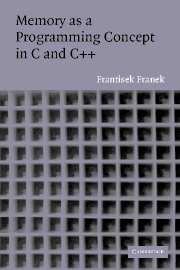Book contents
- Frontmatter
- Contents
- Acknowledgments
- Dedication
- 1 Introduction
- 2 From Source File to Executable File
- 3 Variables and Objects; Pointers and Addresses
- 4 Dynamic Allocation and Deallocation of Memory
- 5 Functions and Function Calls
- 6 One-Dimensional Arrays and Strings
- 7 Multi-Dimensional Arrays
- 8 Classes and Objects
- 9 Linked Data Structures
- 10 Memory Leaks and Their Debugging
- 11 Programs in Execution: Processes and Threads
- A Hanoi Towers Puzzle
- B Tracing Objects in C++
- C Tracing Objects and Memory in C++
- D Thread-Safe and Process - Safe Reporting and Logging Functions
- Glossary
- Index
4 - Dynamic Allocation and Deallocation of Memory
Published online by Cambridge University Press: 13 January 2010
- Frontmatter
- Contents
- Acknowledgments
- Dedication
- 1 Introduction
- 2 From Source File to Executable File
- 3 Variables and Objects; Pointers and Addresses
- 4 Dynamic Allocation and Deallocation of Memory
- 5 Functions and Function Calls
- 6 One-Dimensional Arrays and Strings
- 7 Multi-Dimensional Arrays
- 8 Classes and Objects
- 9 Linked Data Structures
- 10 Memory Leaks and Their Debugging
- 11 Programs in Execution: Processes and Threads
- A Hanoi Towers Puzzle
- B Tracing Objects in C++
- C Tracing Objects and Memory in C++
- D Thread-Safe and Process - Safe Reporting and Logging Functions
- Glossary
- Index
Summary
Fundamentals of dynamic allocation and deallocation of memory: free store (system heap); per-process memory manager; C memory allocators malloc(), calloc(), and realloc(); and C deallocator free(). How to handle memory allocation/deallocation errors.
In previous chapters we have mentioned dynamic allocation of memory several times. In Chapter 2 we had quite a detailed look at the static allocation when we discussed the process of compilation, linking, loading, and execution of a program. We mentioned dynamic allocation from a general point of view or, to be more precise, from the operating system point of view.
The reader should be comfortable with the idea that a running program is allocated several segments - not necessarily contiguous - of memory to which its address space is mapped during program execution. These segments together constitute “the program's memory space”, or the “memory it owns”, where all the program's instructions and data needed for the execution are stored and accessible. It is obvious that many programs need to increase their memory during their execution; for instance, they might need to store more data or even more instructions.
As mentioned at the end of Chapter 2, it would be more precise to talk about a process rather than a running program. Modern operating systems like UNIX thus have a process memory manager, software that is responsible for providing additional allocation of memory to its process and for deallocation when the memory is no longer needed.
- Type
- Chapter
- Information
- Memory as a Programming Concept in C and C++ , pp. 45 - 58Publisher: Cambridge University PressPrint publication year: 2003



